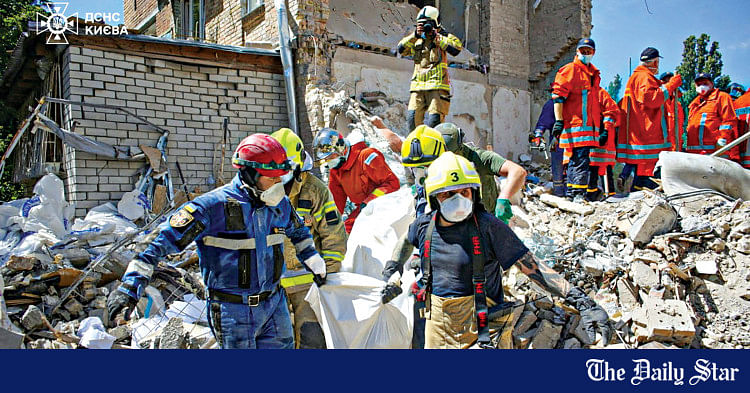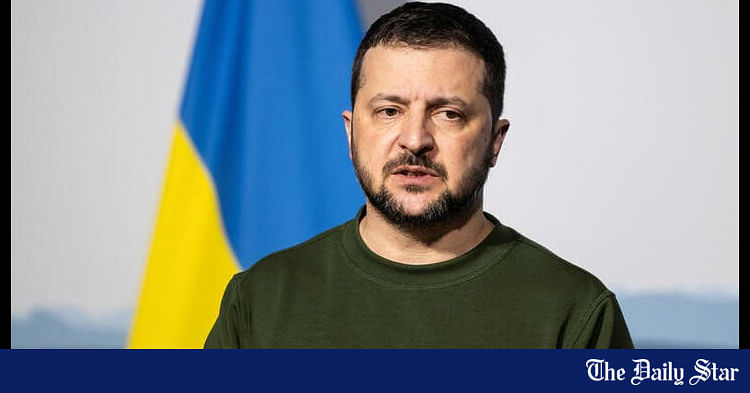Saif
Senior Operative
- 13,311
- 7,274
- Origin

- Axis Group

- Copy to clipboard
- Thread starter
- #41

Ukrainian drones target Russian military airfield, oil refinery
Ukrainian drones targeted a military airfield, an oil refinery and substation in southern Russia, a defence source in Kyiv said yesterday, after Moscow reported an overnight aerial barrage.
Ukrainian drones target Russian military airfield, oil refinery

Rescuers carry the body of a person found under debris at the site where an apartment building was hit by a Russian missile strike in Kyiv, Ukraine yesterday. Targeting hospitals in Ukraine is a "war crime," a senior UN official told an emergency meeting of the Security Council yesterday, called in the wake of deadly strikes that Kyiv blamed on Russia. Photo: REUTERS
Ukrainian drones targeted a military airfield, an oil refinery and substation in southern Russia, a defence source in Kyiv said yesterday, after Moscow reported an overnight aerial barrage.
Kyiv has stepped up cross border aerial attacks on Russia in recent months, attempting to damage energy infrastructure and the Kremlin's war chest by hurting oil revenues.
Russia has launched drone and missiles attacks that have crippled Ukrainian power plants and halved the country's generation capacity.
In an operation coordinated by Security Services of Ukraine and the country's military intelligence, drone spurred explosions at the Akhtyubinsk military airfield in Russia's Astrakhan region.
It also said there had been blasts at an electrical substation in the Rostov region and an oil depot in the southern Volgograd region.
The source added that Ukrainian forces would pursue more strikes on "Russian military facilities working for the war against Ukraine."
There was no response in Moscow to the specific claims.
The Russian defence ministry however had earlier said that its air defence systems had destroyed 38 Ukrainian drones in regions near the border between the two countries, including Rostov and Astrakhan.
Rostov's governor Vasily Golubev in comments to state-run agency TASS acknowledged an electric substation had been damaged in a drone attack, saying repairs would take three days.
And Astrakhan's governor Igor Babushkin said Ukraine had launched a "massive attempt to attack targets with drones" in the north of the region, adding that the attack had been "successfully repelled".
Both sides have used drones, including larger self-detonating craft with ranges stretching hundreds of kilometres extensively throughout the conflict, which began in February 2022.
Rescuers carry the body of a person found under debris at the site where an apartment building was hit by a Russian missile strike in Kyiv, Ukraine yesterday. Targeting hospitals in Ukraine is a "war crime," a senior UN official told an emergency meeting of the Security Council yesterday, called in the wake of deadly strikes that Kyiv blamed on Russia. Photo: REUTERS
Ukrainian drones targeted a military airfield, an oil refinery and substation in southern Russia, a defence source in Kyiv said yesterday, after Moscow reported an overnight aerial barrage.
Kyiv has stepped up cross border aerial attacks on Russia in recent months, attempting to damage energy infrastructure and the Kremlin's war chest by hurting oil revenues.
Russia has launched drone and missiles attacks that have crippled Ukrainian power plants and halved the country's generation capacity.
In an operation coordinated by Security Services of Ukraine and the country's military intelligence, drone spurred explosions at the Akhtyubinsk military airfield in Russia's Astrakhan region.
It also said there had been blasts at an electrical substation in the Rostov region and an oil depot in the southern Volgograd region.
The source added that Ukrainian forces would pursue more strikes on "Russian military facilities working for the war against Ukraine."
There was no response in Moscow to the specific claims.
The Russian defence ministry however had earlier said that its air defence systems had destroyed 38 Ukrainian drones in regions near the border between the two countries, including Rostov and Astrakhan.
Rostov's governor Vasily Golubev in comments to state-run agency TASS acknowledged an electric substation had been damaged in a drone attack, saying repairs would take three days.
And Astrakhan's governor Igor Babushkin said Ukraine had launched a "massive attempt to attack targets with drones" in the north of the region, adding that the attack had been "successfully repelled".
Both sides have used drones, including larger self-detonating craft with ranges stretching hundreds of kilometres extensively throughout the conflict, which began in February 2022.






